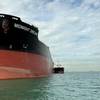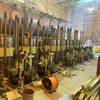Hornbeck Offshore Q1 2010 Results
Hornbeck Offshore Services, Inc. (NYSE: HOS) announced results for the first quarter ended March 31, 2010.
First quarter 2010 revenues decreased 21.4% to $86.2 million compared to $109.6 million for the first quarter of 2009 and decreased 2.4% compared to $88.3 million for the fourth quarter of 2009. Operating income was $15.7 million, or 18.2% of revenues, for the first quarter of 2010 compared to $45.4 million, or 41.4% of revenues, for the prior-year quarter; and $24.2 million, or 27.4% of revenues, for the fourth quarter of 2009. Net income for the first quarter of 2010 was $2.6 million, or $0.09 per diluted share, compared to $27.1 million, or $1.01 per diluted share for the year-ago quarter; and $9.3 million, or $0.34 per diluted share for the fourth quarter of 2009. EBITDA for the first quarter of 2010 was $33.5 million compared to first quarter 2009 EBITDA of $60.3 million and fourth quarter 2009 EBITDA of $41.2 million. The year-over-year decrease in revenues, operating income and EBITDA was primarily due to a substantial decline in fleetwide average dayrates and utilization for both of the company's segments. Included in first quarter 2010 results was a $0.5 million ($0.3 million after-tax, or $0.01 per diluted share) gain on the sale of one conventional offshore supply vessel (OSV) for net cash proceeds of $1.3 million compared to a $0.2 million ($0.2 million after-tax or $0.01 per diluted share) gain on the sale of an older, lower horsepower tug in the first quarter of 2009. For additional information regarding EBITDA as a non-GAAP financial measure, please see Note 10 to the accompanying data tables.
Upstream Segment. Revenues from the Upstream segment were $76.6 million for the first quarter of 2010, a decrease of $14.0 million, or 15.5%, from $90.6 million for the same period in 2009 and a decrease of $2.1 million, or 2.7%, from $78.7 million for the fourth quarter of 2009. The year-over-year net decrease in revenues was comprised of a $40.2 million revenue decline primarily resulting from lower effective dayrates for the Company's new generation OSVs that were in service since March 31, 2009 and, to a lesser extent, reduced demand for services at the company's shore-base port facility. In addition, the company experienced a $1.6 million decrease in revenue from its non-core conventional OSVs that were in service during the quarter ended March 31, 2009, but which were either stacked or sold on various dates since then. These revenue decreases were partially offset by increased revenues from the vessels placed in service since early 2009 under the company's newbuild and conversion programs of $27.8 million. Continued soft OSV market conditions in the U.S. Gulf of Mexico (GoM) contributed to Upstream operating income decreasing 61.1% to $17.2 million, or 22.5% of revenues, for the first quarter of 2010 from $44.2 million, or 48.8% of revenues, for the first quarter of 2009. As a result of weak market conditions that have existed since early 2009, the company continued to have eight new generation OSVs stacked during the first quarter of 2010. These market conditions were the primary driver for ave rage new generation OSV dayrates for the first quarter of 2010 declining to $19,986 compared to $23,085 for the same period in 2009, and new generation OSV utilization declining to 72.9% for the first quarter of 2010 compared to 93.0% for the year-ago quarter. Effective new generation OSV utilization for the company's active fleet, which excludes the impact of stacked vessels, was 87.3% for the first quarter of 2010 compared to 89.2% for the fourth quarter of 2009. Average utilization for the first quarter of 2010 was also adversely affected by roughly 282 out-of-service days for vessels that were mobilizing for multi-year charters in Latin America.
Downstream Segment. Revenues from the Downstream segment of $9.6 million for the first quarter of 2010 decreased by $9.5 million, or 49.7%, compared to $19.1 million for the same period in 2009, but were in-line with the sequential quarter. Downstream revenues were unfavorably impacted by continued lower demand since the year-ago period for the company's ocean-going tug and tank barge (TTB) equipment, which was primarily driven by soft market conditions and, to a lesser extent, the OPA 90 retirement of one of its larger, single-hulled tank barges in June 2009. These conditions resulted in the stacking of all of the Company's single-hulled tank barges on various dates since the second quarter of 2008. The Company's double-hulled tank barge average dayrates were $15,816 for the first quarter of 2010 compared to $20,406 for the same period in 2009. Utilization for the double-hulled tank barge fleet was 75.1% for the first quarter of 2010 compared to 80.0% for the same period in 2009. The year-over-year decrease in the company's double-hulled tank barge dayrates and utilization was the result of the continued decline in market demand for petroleum products in the U.S. as a result of the current economic slowdown and an estimated 1.1 million-barrel increase in industry-wide newbuild double-hulled tank barge capacity during 2009.
General and Administrative ("G&A"). G&A expenses of $8.9 million for the first quarter of 2010 were 10.3% of revenues compared to $8.8 million, or 8.0% of revenues, for the first quarter of 2009. First quarter G&A expense margin was in-line with the Company's 2010 annual guidance range of 9% to 11% of revenues. The Company allocated 92% of its first quarter G&A expenses to the Upstream segment and 8% to the Downstream segment.
Depreciation and Amortization. Depreciation and amortization expense was $17.8 million for the first quarter of 2010, or $2.7 million higher than the first quarter of 2009. This increase was due to the incremental depreciation related to the full- or partial-quarter contribution from nine new generation OSVs and two MPSVs that were placed in service since early 2009. Depreciation and amortization expense is expected to continue to increase from current levels as the last two remaining vessels under the Company's fourth OSV newbuild program are placed in service and when these and any other recently acquired and newly constructed vessels undergo their initial 30-month and 60-month recertifications.
Interest expense increased $9.0 million during the three months ended March 31, 2010 compared to the same period in 2009. The increase in interest expense is primarily attributable to additional interest costs related to the Company's $250.0 million of 8.000% senior notes due 2017, which were issued in August 2009; and lower capitalized interest driven by having fewer vessels being constructed under the Company's newbuild and conversion programs. The Company capitalized construction period interest of $2.6 million for the first quarter 2010, which represents roughly 20% of its total interest costs for the quarter. With its newbuild and conversion programs scheduled to be completed by August 2010, the Company expects to capitalize annual construction period interest of $3.3 million, or only 6% of its total interest costs for the full fiscal year 2010.
The company expects total EBITDA for fiscal 2010 to range between $160.0 million and $200.0 million and expects full-year diluted EPS for fiscal 2010 to range between $0.58 and $1.50. Excluding incremental non-cash OID interest expense related to the Company's convertible senior notes, adjusted EPS for fiscal 2010 is expected to range between $0.81 and $1.73.
The company's full-year 2010 Upstream guidance includes a partial-year contribution from additional vessels delivered or to be delivered in 2010 under its MPSV program and its fourth OSV newbuild program in accordance with the actual and estimated newbuild delivery expectations discussed below. The company expects to own 51 new generation OSVs as of December 31, 2010. The vessel additions under the fourth OSV newbuild program should result in a projected average new generation OSV fleet complement of 49.9 vessels for the fiscal year 2010. The company is now in the process of reactivating two of its eight new generation OSVs that are currently stacked. Assuming the other six inactive vessels remain stacked and given the recent sale of one stacked conventional OSV, the Upstream guidance gives effect to an annual average of 6.8 new generation OSVs and 2.2 conventional OSVs being stacked throughout fiscal 2010. Accordingly, the Company's active fleet of new generation OSVs, which averaged 39.2 vessels for fiscal 2009, is expected to average 43.1 vessels for fiscal 2010.
Fleetwide average new generation OSV dayrates are anticipated to be in the $18,000 to $20,000 range and fleetwide new generation OSV utilization for the 49.9-vessel fleet is anticipated to average in the low to mid-70% range during the 2010 guidance period. This average utilization estimate allows for approximately 630 days of aggregate downtime, 282 days of which were incurred during the first quarter, related to customer-required modifications and pre-positioning of the eight vessels that are mobilizing to Latin America during the first half of 2010 for multi-year charters.
The company owns and is operating an average MPSV fleet complement of 3.8 vessels in the spot market for the fiscal year 2010. However, the DP-3 HOS Achiever is expected to incur roughly 120 days out-of-service during the first half of 2010, 45 days of which occurred during the first quarter, for the installation of a 100-ton crane. This crane installation downtime reduces the effective MPSV fleet complement for the year to 3.5 vessel-equivalents, up from 1.8 vessels in 2009. Based on the Company's current spot dayrate and utilization assumptions for its four MPSVs, these vessels are expected to produce EBITDA in the range of 20% to 30% of the mid-point of the company-wide fiscal 2010 guidance range compared to approximately 15% of the Company's actual EBITDA for fiscal 2009.
The 2010 Downstream guidance reflects an active operating fleet comprised solely of nine double-hulled tank barges and ten ocean-going tugs for the fiscal year 2010. These vessels are projected to contribute EBITDA in the range of 3% to 6% of the mid-point of the company-wide fiscal 2010 guidance range compared to approximately 8% of the company's actual EBITDA for fiscal 2009. The Company will consider stacking one or more double-hulled barges and additional tugs in its Downstream segment during 2010, if necessary, to deter further operating margin declines.
The company expects that cash operating expenses per OSV vessel-day in fiscal 2010 will be in-line with fiscal 2009 levels for vessels that were in service for each of the past two years, excluding contract-related costs recoverable through higher dayrates or other revenue. The company has mitigated the adverse impact of revenue decreases on its operating margins by stacking under-utilized vessels, which has resulted in additional operating cost savings and lowered the Company's operating risk profile for fiscal 2010.
G&A expenses are expected to be in the range of 9% to 11% of revenues for the 2010 guidance period. The projected annual stock-based compensation expense, depreciation, amortization and net interest expense that underpin the Company's diluted EPS guidance for the full-year 2010 are included in the attached data tables. Projected quarterly stock-based compensation expense, depreciation, amortization and net interest expense for the quarter ending June 30, 2010 are expected to be $2.2 million, $14.9 million, $5.2 million and $14.0 million, respectively. The company's annual effective tax rate is expected to be 36.9% for fiscal 2010.
Update on Maintenance and Other Capital Expenditures. Maintenance capital expenditures, which are recurring in nature, primarily include regulatory drydocking charges incurred for the recertification of vessels and other vessel capital improvements that extend a vessel's economic useful life. Other capital expenditures, which are generally non-recurring, are comprised of the following: (i) commercial-related vessel improvements, such as cranes, remotely operated vehicles (ROVs) and other specialized vessel equipment, which costs are typically included in and offset by higher dayrates charged to customers; and (ii) non-vessel related capital expenditures, including costs related to the Company's shore-based facilities or leasehold improvements and other corporate expenditures, such as information technology or office furniture and equipment. The company expects maintenance capital expenditures and other capital expenditures to each be approximately $27.4 million for the full-year 2010. Over the next few years beyond 2010, the company expects that its annually recurring maintenance capital expenditure budget for its growing fleet of vessels will range between $35.0 million and $45.0 million per year.
Update on MPSV Program. The company's MPSV program consisted of the conversion of two U.S.-flagged coastwise sulfur tankers at domestic shipyards into 370 class DP-2 new generation MPSVs and the construction of two 430 class DP-3 new generation MPSV newbuilds in foreign shipyards. With the recent delivery of the second 370 class DP-2 MPSV, HOS Strongline, which was placed in service in late March 2010, the company's MPSV program is now complete. Based on internal estimates, the aggregate cost of this program is expected to be approximately $490.5 million. From the inception of this program through March 31, 2010, the company has incurred $489.8 million of total expected project costs, including $5.2 million incurred during the first quarter of 2010.
Update on OSV Newbuild Program #4. The company's fourth OSV newbuild program consisted of vessel construction contracts with three domestic shipyards to build six 240 ED class OSVs, nine 250 EDF class OSVs and one 290 class OSV, respectively. The Company has already added 14 of these 16 new generation DP-2 OSVs to its Upstream fleet on various dates since May 2008. The two remaining OSVs under this newbuild program, the HOS Windancer and HOS Wildwing, are expected to be placed in service in May and August 2010, respectively. Inclusive of the vessel deliveries referred to above, the aggregate cost of this program is expected to be approximately $445.0 million. From the inception of this program through March 31, 2010, the company has incurred $420.2 million of total expected project costs, including $14.3 million incurred during the first quarter of 2010.












